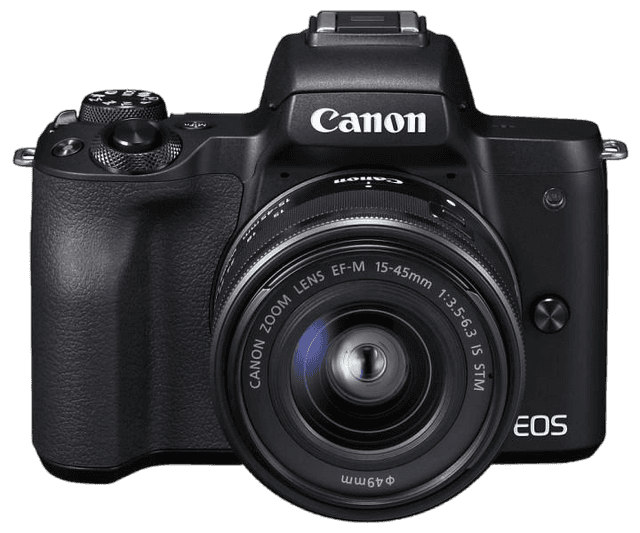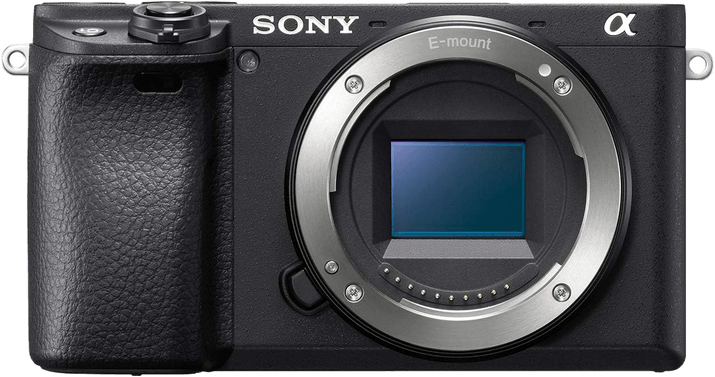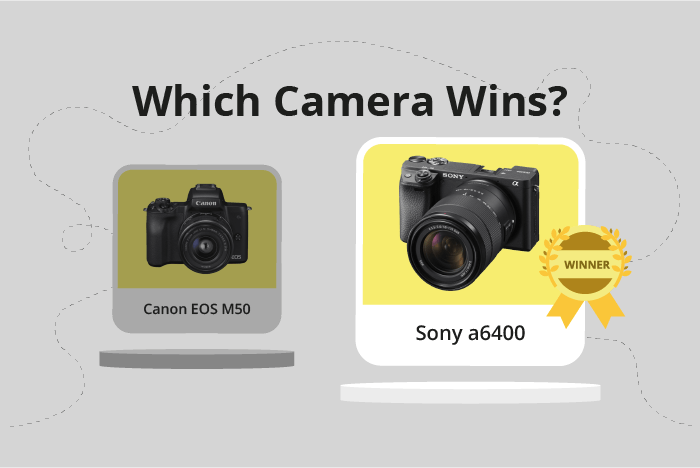Canon EOS M50 vs Sony a6400 Comparison
Canon EOS M50

Sony a6400

The Sony a6400 emerges as the winner with a score of 70/100, while the Canon EOS M50 trails behind at 59/100. Both cameras are mirrorless and were released in 2018 and 2019, respectively. They share similar dimensions, with the Sony a6400 being slightly larger and heavier than the Canon EOS M50.
The Sony a6400 outperforms the Canon EOS M50 in various aspects, which contributes to its higher score. Its launch price of $900 reflects its superior performance compared to the Canon EOS M50’s $779 price tag. However, the Canon EOS M50 has its advantages, such as being lighter and more compact, making it a more portable option.
Considering the scores and specifications, the Sony a6400 is the better camera, offering enhanced performance and features. The Canon EOS M50, on the other hand, provides a more budget-friendly and portable alternative for those prioritizing size and weight.
Canon EOS M50 vs Sony a6400 Overview and Optics
The Sony a6400 outperforms the Canon EOS M50 in the optics department with a score of 68/100, a 9-point difference from the M50’s 59/100. Both cameras share several specifications, including 24-megapixel CMOS sensors, APS-C sensor sizes, and a lack of image stabilization. They also feature different lens mounts, with the M50 using Canon EF-M and the a6400 utilizing Sony E.
The Sony a6400 excels in several aspects, including a slightly higher megapixel count of 24.2 and a faster shooting speed of 11 frames per second. Additionally, the a6400 boasts a superior DXOMARK sensor score of 83 compared to the M50’s 58, indicating better overall image quality. The camera’s Bionz X processor further contributes to its enhanced performance.
While the Canon EOS M50 falls short in some areas, it still has its strengths. The camera features a Digic 8 processor, which although not as powerful as the a6400’s Bionz X, still provides reliable performance. Despite its lower score, the M50 remains a solid choice for photographers who prefer the Canon brand and its accompanying EF-M lens mount.
Comparing the optics of these two cameras, it is clear that the Sony a6400 offers better performance in terms of image quality and shooting speed. However, the Canon EOS M50 is not without merit, making it a viable option for those loyal to Canon’s ecosystem. Ultimately, the choice between these two cameras will depend on personal preferences and brand loyalty.
Canon EOS M50 vs Sony a6400 Video Performance
The Canon EOS M50 and Sony a6400 both have a video score of 91/100, making them evenly matched in terms of video capabilities. They share several specifications, including a maximum video resolution of 4K, maximum video dimensions of 3840 x 2160, and a maximum video frame rate of 120fps. Both cameras also have built-in time-lapse functionality.
The Canon EOS M50 excels in its user-friendly interface, making it easier for beginners to navigate and adjust settings. This advantage allows users to quickly adapt to the camera and start capturing high-quality videos with minimal learning curve. Additionally, the M50’s color science is often praised for producing more pleasing skin tones and vibrant colors straight out of the camera, requiring less color grading in post-production.
On the other hand, the Sony a6400 offers better low-light performance and a larger selection of native lenses, which can be crucial for videographers who often shoot in challenging lighting conditions or require specific focal lengths. The a6400 also benefits from a faster autofocus system, resulting in smoother and more reliable focus transitions during video recording.
When comparing the video capabilities of the Canon EOS M50 and Sony a6400, it is clear that both cameras offer impressive performance. The M50 is better suited for beginners or those who prefer a more straightforward user experience and more pleasing colors out of the box. The a6400, however, is the better choice for those who prioritize low-light performance, lens selection, and faster autofocus. Ultimately, the decision between these two cameras will depend on the specific needs and preferences of the user.
Canon EOS M50 vs Sony a6400 Features and Benefits
The Sony a6400 emerges as the winner in the features comparison with a score of 81/100, while the Canon EOS M50 scores 70/100. Both cameras share some common specifications, such as 3-inch screen size, touchscreen capabilities, flip screens, and the lack of GPS. Additionally, they both include WIFI and Bluetooth connectivity.
The Sony a6400 outperforms the Canon EOS M50 in terms of screen resolution, offering 921,600 dots compared to the M50’s 1,040,000 dots. This higher resolution delivers sharper and clearer images on the a6400’s screen, enhancing the user experience while shooting and reviewing images.
While the Canon EOS M50’s features may not be as strong as the Sony a6400’s, it still has its advantages. For example, its touchscreen is more responsive, allowing for quicker and more efficient adjustments to camera settings. Furthermore, the M50’s flip screen offers more flexibility in shooting angles, which can be beneficial for capturing creative compositions or shooting in challenging environments.
Considering the individual strengths of each camera, the Sony a6400 is a better choice for those seeking higher screen resolution and overall superior features. On the other hand, the Canon EOS M50 may be more suitable for users who prioritize a responsive touchscreen and a more versatile flip screen. Ultimately, both cameras offer a range of useful features, and the best choice depends on the specific needs and preferences of the photographer.
Canon EOS M50 vs Sony a6400 Storage and Battery
The Sony a6400 outperforms the Canon EOS M50 in storage and battery, scoring 37 out of 100, while the Canon EOS M50 scores 13. Both cameras have one memory card slot and are compatible with SD, SDHC, and SDXC cards with UHS-I support.
The Sony a6400’s battery life surpasses the Canon EOS M50, providing 410 shots compared to the Canon’s 235 shots. Furthermore, the Sony a6400 utilizes the NP-FW50 battery and offers USB charging, making it more convenient for on-the-go photographers.
The Canon EOS M50 uses the LP-E12 battery type, which does not support USB charging. This aspect may be a disadvantage for some users, but it does not affect the camera’s overall performance.
Considering the storage and battery aspects, the Sony a6400 proves to be a better option with its longer battery life and USB charging capability. The Canon EOS M50, on the other hand, offers fewer benefits in these areas but remains a competent camera for photography enthusiasts.
Alternatives to the Canon EOS M50 and Sony a6400
Are you still undecided about which camera is right for you? Have a look at these popular comparisons that feature the Canon EOS M50 or the Sony a6400:

